UPDATE: I’ve discussed the unexpected surge in the sea surface temperatures of the extratropical North Pacific in the post here.
###
UNUSUAL WARMING EVENT IN EXTRATROPICAL NORTH PACIFIC
The sea surface temperature anomalies in the extratropical North Pacific (24N-65N, 100E-100W) spiked in July 2013, warming almost 0.43 deg C since June. We’ll discuss this in a separate post that will follow, hopefully, today or tomorrow. (Preview: Based on NOAA’s long-term reconstruction, ERSST.v3b [not shown], the magnitude of the one-month spike is not unusual.)
Extratropical North Pacific Sea Surface Temperature (SST) Anomalies
(24N-65N, 100E-100W)
Monthly Change = +0.428 Deg C
####################################
MONTHLY SEA SURFACE TEMPERATURE ANOMALY MAP
The following is a Global map of Reynolds OI.v2 Sea Surface Temperature (SST) anomalies for July 2013. It was downloaded from the NOMADS website. The contour levels are set at 0.5 deg C, and white is set at zero.
July 2013 Sea Surface Temperature (SST) Anomalies Map
(Global SST Anomaly = +0.263 deg C)
MONTHLY OVERVIEW
The sea surface temperature anomalies for the NINO3.4 region in the eastern equatorial Pacific (5S-5N, 170E-120E) are a commonly used index for the strength, frequency and duration of El Niño and La Nina events. We keep an eye on the sea surface temperatures there because El Niño and La Niña events are the primary cause of the yearly variations in global sea surface temperatures AND they are the primary cause of the long-term warming of global sea surface temperatures over the past 30 years. See the discussion of the East Pacific versus the Rest-of-the-World that follows.
Monthly NINO3.4 sea surface temperature anomalies are still below zero. In the most recent month they cooled about 0.1 deg C (-0.097 deg C). They’re presently at about -0.175 deg C. They’re well within El Niño-Southern Oscillation (ENSO)-neutral conditions, meaning they’re not El Niño or La Niña conditions. Also refer to the discussion of the weekly NINO3.4 data near the bottom of the post.
Global Sea Surface Temperature anomalies warmed almost 0.08 deg C (+0.077 deg C) from June to July, with a sizable warming in the Northern Hemisphere being offset by the minor cooling in the Southern Hemisphere. This was led by the unusual spike in extratropical North Pacific discussed above. That of course carried over to the entire North Pacific, but it was suppressed by the South Pacific, which cooled slightly. The ocean basins that cooled in July were the South Pacific, Indian, and Southern Ocean. The monthly Global Sea Surface Temperature anomalies are presently at +0.263 deg C.
(1) Global Sea Surface Temperature Anomalies
Monthly Change = +0.077 deg C
####################################
(2) NINO3.4 Sea Surface Temperature Anomalies
(5S-5N, 170W-120W)
Monthly Change = -0.097 deg C
####################################
THE EAST PACIFIC VERSUS THE REST OF THE WORLD
The East Pacific and the Rest-Of-The-World (Atlantic-Indian-West Pacific) datasets were first discussed in the post Sea Surface Temperature Anomalies – East Pacific Versus The Rest Of The World, and were discussed a few months later in How Can Things So Obvious Be Overlooked By The Climate Science Community?
They were also discussed in great detail in my recently published book Who Turned on the Heat? The Unsuspected Global Warming Culprit, El Niño-Southern Oscillation. The Updated Free Preview includes the Table of Contents; the Introduction; the beginning of Section 1, with the cartoon-like illustrations; the discussion About the Cover; and the Closing. Also see the blog post Everything You Every Wanted to Know about El Niño and La Niña… for an overview. The book is only US$8.00. Please click here to buy a copy. (Paypal or Credit/Debit Card. You do not need to open a PayPal account.)
In the following two graphs, both datasets have been adjusted for the impacts of volcanic aerosols. I’m considering eliminating the volcano adjustments, because they add very little to the discussion. In fact, some persons use those adjustments as an excuse to disregard the obvious.
The global oceans were divided into these two subsets to illustrate a couple of facts. First, the linear trend of the volcano-adjusted East Pacific (90S-90N, 180-80W) Sea Surface Temperature anomalies since the start of the Reynolds OI.v2 dataset is basically flat. That is, the East Pacific hasn’t warmed in 31+ years. The East Pacific is not a small region. It represents about 33% of the surface area of the global oceans. The East Pacific linear trend varies very slightly with each monthly update. But it won’t vary significantly between El Niño and La Niña events.
(3) Volcano-Adjusted East Pacific Sea Surface Temperature (SST) Anomalies
(90S-90N, 180-80W)
####################################
And second, the volcano-adjusted Sea Surface Temperature anomalies for the Rest of the World (90S-90N, 80W-180) rise in very clear steps, in response to the significant 1986/87/88 and 1997/98 El Niño/La Niña events. It also appears as though the Sea Surface Temperature anomalies of this dataset July have made another upward shift in response to the 2009/10 El Niño and 2010/11 La Niña events. For those who are interested in the actual trends of the Sea Surface Temperature anomalies between the 1986/87/88 and 1997/98 El Niño events and between the 1997/98 and 2009/10 El Niño events refer to Figure 4 in Does The Sea Surface Temperature Record Support The Hypothesis Of Anthropogenic Global Warming? I further described (at an introductory level) the ENSO-related processes that cause these upward steps in the post ENSO Indices Do Not Represent The Process Of ENSO Or Its Impact On Global Temperature. And as noted above, it is discussed in detail in my recently published book Who Turned on the Heat? The Unsuspected Global Warming Culprit, El Niño-Southern Oscillation.
(4) Volcano-Adjusted Sea Surface Temperature Anomalies For The Rest of the World
(90S-90N, 80W-180)
####################################
The periods used for the average Rest-Of-The-World Sea Surface Temperature anomalies between the significant El Niño events of 1982/83, 1986/87/88, 1997/98, and 2009/10 are determined as follows. Using the original NOAA Oceanic Nino Index (ONI) for the official months of those El Niño events, I shifted (lagged) those El Niño periods by six months to accommodate the lag between NINO3.4 SST anomalies and the response of the Rest-Of-The-World Sea Surface Temperature anomalies, then deleted the Rest-Of-The-World data that corresponds to those significant El Niño events. I then averaged the Rest-Of-The-World SST anomalies between those El Niño-related gaps.
The “Nov 2010 to Present” average varies with each update. As noted in the post Sea Surface Temperature Anomalies – East Pacific Versus The Rest Of The World, it will be interesting to see where that Sea Surface Temperature anomaly average settles out, if it does, before the next significant El Niño drives them higher.
Of course, something could shift. Will the upward ratcheting continue when the Atlantic Multidecadal Oscillation (AMO) decides to turn around and start its decline? The upward steps would not continue in the North Atlantic, but would the AMO impact the upward steps in other portions of the globe? For more information about the Atlantic Multidecadal Oscillation, refer to the post An Introduction To ENSO, AMO, and PDO — Part 2.
The Sea Surface Temperature anomalies of the East Pacific Ocean, or approximately 33% of the surface area of the global oceans, have decreased slightly since 1982 based on the linear trend. And between upward shifts, the Sea Surface Temperature anomalies for the rest of the world (67% of the global ocean surface area) remain relatively flat. As discussed in my book, anthropogenic forcings are said to be responsible for most of the rise in global surface temperatures over this period, but the Sea Surface Temperature anomaly graphs of those two areas prompt a two-part question: Since 1982, what anthropogenic global warming processes would overlook the Sea Surface Temperatures of 33% of the global oceans and have an impact on the other 67% but only during the months of the significant El Niño events of 1986/87/88, 1997/98 and 2009/10?
STANDARD NOTE ABOUT THE DATA
Other than the East Pacific and Rest-of-the-World data shown immediately above, the MONTHLY graphs illustrate raw monthly OI.v2 sea surface temperature anomaly data from November 1981 to July 2013, as it is presented by the NOAA NOMADS website linked at the end of the post. NOAA uses the base years of 1971-2000 for this dataset. I’ve added the 13-month running-average filter to smooth out the seasonal variations.
MONTHLY INDIVIDUAL OCEAN AND HEMISPHERIC SEA SURFACE TEMPERATURE UPDATES
(5) Northern Hemisphere Sea Surface Temperature (SST) Anomalies
Monthly Change = +0.180 deg C
####################################
(6) Southern Hemisphere Sea Surface Temperature (SST) Anomalies
Monthly Change = -0.004 deg C
####################################
(7) North Atlantic Sea Surface Temperature (SST) Anomalies
(0 to 70N, 80W to 0)
Monthly Change = =0.203 deg C
####################################
(8) South Atlantic Sea Surface Temperature (SST) Anomalies
(0 to 60S, 70W to 20E)
Monthly Change = +0.044 deg C
Note: I discussed the (now apparently temporary) upward shift in the South Atlantic Sea Surface Temperature anomalies in the post The 2009/10 Warming Of The South Atlantic. Prior to that shift, the South Atlantic sea surface temperature anomalies had been relatively flat for about two decades. It now looks as though the South Atlantic sea surface temperature anomalies have dropped below the level they were at before that surge.
####################################
(9) Pacific Sea Surface Temperature (SST) Anomalies
(60S to 65N, 120E to 80W)
Monthly Change = =0.107 Deg C
####################################
(10) North Pacific Sea Surface Temperature (SST) Anomalies
(0 to 65N, 100E to 90W)
Monthly Change = +0.219 Deg C
####################################
(11) South Pacific Sea Surface Temperature (SST) Anomalies
(0 to 60S, 120E to 70W)
Monthly Change = -0.013 deg C
####################################
(12) Indian Ocean Sea Surface Temperature (SST) Anomalies
(60S to 30N, 20E to 120E)
Monthly Change = -0.033 deg C
####################################
(13) Arctic Ocean Sea Surface Temperature (SST) Anomalies
(65N to 90N)
Monthly Change = +0.197 deg C
####################################
(14) Southern Ocean Sea Surface Temperature (SST) Anomalies
(90S-60S)
Monthly Change = -0.042 deg C
####################################
WEEKLY SEA SURFACE TEMPERATURE ANOMALIES
The NINO3.4 Sea Surface Temperature anomalies based on the week centered on July 31, 2013 are below zero but well above La Niña conditions, which are defined by NOAA as being cooler than -0.5 deg C. They are presently at -0.125 deg C.
(15) Weekly NINO3.4 Sea Surface Temperature (SST) Anomalies
####################################
Global sea surface temperature anomalies had been warming for a few months. They are at +0.295 deg C.
(16) Weekly Global Sea Surface Temperature (SST) Anomalies
####################################
The NINO1+2 region is in the far eastern tropical Pacific. It is bordered by the coordinates of 10S-0, 90W-80W. Weekly sea surface temperature anomalies there are still very cool for an ENSO neutral period. They are presently at -1.48 deg C.
(17) Weekly NINO1+2 Sea Surface Temperature (SST) Anomalies
####################################
INTERESTED IN LEARNING MORE ABOUT HOW AND WHY THE GLOBAL OCEANS INDICATE THEY’VE WARMED NATURALLY?
Why should you be interested? The hypothesis of manmade global warming depends on manmade greenhouse gases being the cause of the recent warming. But the sea surface temperature record indicates El Niño and La Niña events are responsible for the warming of global sea surface temperature anomalies over the past 31 years, not manmade greenhouse gases. Scroll back up to the discussion of the East Pacific versus the Rest of the World. I’ve searched sea surface temperature records for more than 4 years, and I can find no evidence of an anthropogenic greenhouse gas signal. That is, the warming of the global oceans has been caused by Mother Nature, not anthropogenic greenhouse gases.
I’ve recently published my e-book (pdf) about the phenomena called El Niño and La Niña. It’s titled Who Turned on the Heat? with the subtitle The Unsuspected Global Warming Culprit, El Niño Southern Oscillation. It is intended for persons (with or without technical backgrounds) interested in learning about El Niño and La Niña events and in understanding the natural causes of the warming of our global oceans for the past 30 years. Because land surface air temperatures simply exaggerate the natural warming of the global oceans over annual and multidecadal time periods, the vast majority of the warming taking place on land is natural as well. The book is the product of years of research of the satellite-era sea surface temperature data that’s available to the public via the internet. It presents how the data accounts for its warming—and there are no indications the warming was caused by manmade greenhouse gases. None at all.
Who Turned on the Heat? was introduced in the blog post Everything You Ever Wanted to Know about El Niño and La Niña… …Well Just about Everything. The Updated Free Preview includes the Table of Contents; the Introduction; the beginning of Section 1, with the cartoon-like illustrations; the discussion About the Cover; and the Closing.
Please buy a copy. (Paypal or Credit/Debit Card). You do not need to have a PayPal account. Simply scroll down to the purchase option Simply scroll down to the “Don’t Have a PayPal Account” purchase option. It’s only US$8.00.
SOURCES
The Sea Surface Temperature anomaly data used in this post is available through the NOAA NOMADS website:
http://nomad1.ncep.noaa.gov/cgi-bin/pdisp_sst.sh
or:



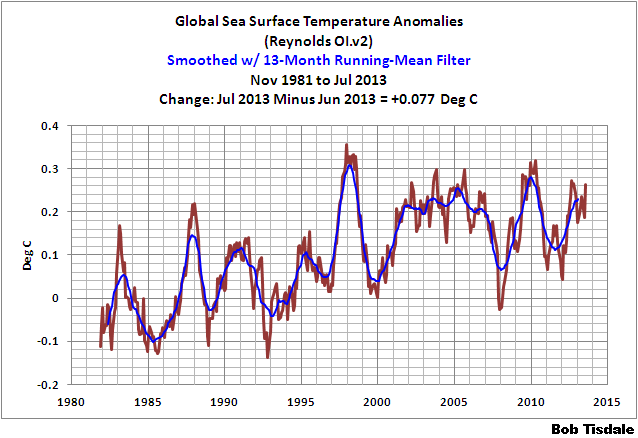
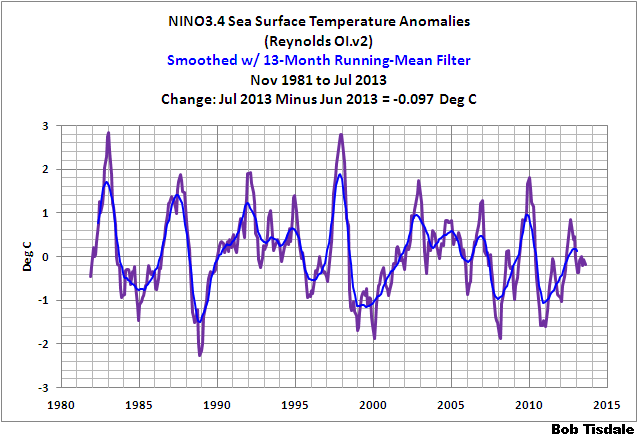



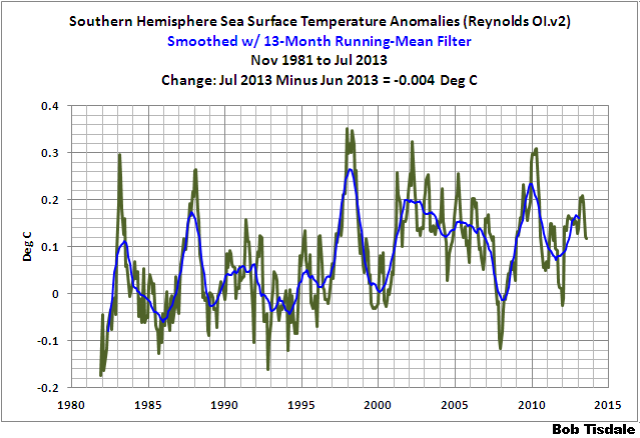
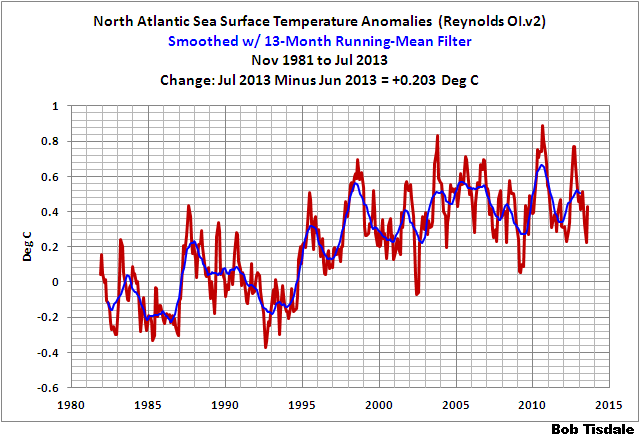





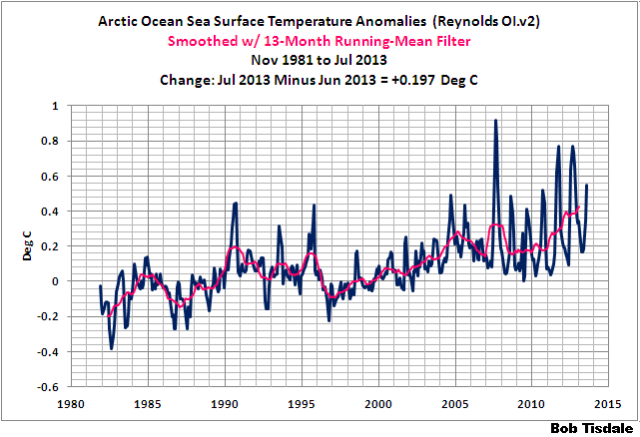






Hi Bob
I’ve got to say .. You are the hardest working man in climate science. The James Brown of ENSO study. I appreciate what you do.
After reading your june 4 post about Trenberth’s “Big Jumps”, the graph(figure 8) suggested to me the possibility of a Jupiter/Sun tidal influence. Those red spikes happen to coincide with Jupiter perihelion. How do you feel about this.
“the magnitude of the one-month spike is not unusual.”
Really? Because that graph makes it look highly unusual.
Man, I sure miss Intrade… It was the proof that you people are too scared of your own tenuous grasp on reality to actually put your money where your mouths are.
Anyone ever wants to bet on this stuff, get in touch. We’ll work out a bet, and loser pays winner’s charity.
Scott Supak (@ssupak) says: “Really? Because that graph makes it look highly unusual.”
Glad to see you take things out of context, Scott Supak. The parenthetical sentence you quoted part of reads in full:
(Preview: Based on NOAA’s long-term reconstruction, ERSST.v3b [not shown], the magnitude of the one-month spike is not unusual.)
Scott Supak (@ssupak) says: “Man, I sure miss Intrade… It was the proof that you people are too scared of your own tenuous grasp on reality to actually put your money where your mouths are.”
The only person with a tenuous grasp of reality appears to be you, Scott Supak. Hence your need to quote out of context.
Adios!
Thanks, Bob, a great effort once again, I look forward to this page every month. I have been wondering how long before the Indian Ocean values would fall, as we had record rainfall here in the NW Australia in May and June, a very welcome record too. I have also noticed considerable cloud cover over a lot of the tropical Indian Ocean during that same period.
Pingback: About the Unusual Warming Event in Extratropical North Pacific Sea Surface Temperature Anomalies | Bob Tisdale – Climate Observations
TLMango: Sorry for the delay in replying. I can’t reply to your question because I don’t study the tidal influences of planets. I’m interested in the processes and aftereffects of ENSO.
Thanks for the “You are the hardest working man in climate science. The James Brown of ENSO study.” I enjoyed that. Too bad I’m not the hardest working pensioner at the gym. If I was, I could get rid of the 30 pounds I’m trying to lose.
Regards
Bob: “The only person with a tenuous grasp of reality appears to be you, Scott Supak. Hence your need to quote out of context.”
If you doubt my grasp of reality, then perhaps you’d like to bet on future temperatures? Winner pays loser’s charity.
It’s really odd to me that you people are so sure of yourselves, and yet you won’t bet…
Pingback: About the Unusual Warming Event in Extratropical North Pacific Sea Surface Temperature Anomalies | Watts Up With That?
Scott Supak says: “It’s really odd to me that you people are so sure of yourselves…”
I present data, Scott Supak. That’s why I’m sure of myself.
You on the other hand have presented nothing of value here, Scott Supak. Absolutely nothing of value. You’ve managed to waste my time by quoting me out of context in an earlier comment and you’ve pissed me off with the “you people”.
Adios!
That last comment, Bob, from web Page, is spam, the filters are not working as well these days.
Pingback: researchers, outfoxed … | pindanpost
Thanks, Tom. I missed it too.
Too bad I’m not the hardest working pensioner at the gym. If I was, I could get rid of the 30 pounds I’m trying to lose.
You do not have to be..
http://articles.mamaslatinas.com/health_fitness/109179/lose_weight_with_just_3
First discovered from work done with diabetics, as was the following.:
http://abcnews.go.com/Health/feast-famine-controversial-fast-diet-weight-loss-plan/story?id=18613821
There are more scholarly pages on this.., but these to give a quick flavour of the new thinking.
The 2 day fasting a week was refined to 2 consecutive days for reasons I do not now recall, something to do with how much time it takes before the body kicks into a different mode. IIRC this began originally by a recommended every other day fasting, again from clinic work with diabetics and heart patients.
And, I have just remembered, the precursor to this could have been the month long fast to completely reset the diabetic’s metabolism to produce his own insulin.
This says it took two months, (I recall a diabetic’s story of his experience in which it took one month): http://www.cbsnews.com/8301-504763_162-20074135-10391704.html
The intense exercise is perhaps easiest on the bicycle in the gym, you can collapse on the handlebars for your short rest in between spurts..
Thanks for exercise tip and the links to the new diet, Myrrh. It’s worth a shot. I’ll try it.
I lost about 15 pounds over a 3-month period with diet and light exercise, then reached a plateau. I increased the time and intensity of biking, walking, light weights, etc but still no more weight loss. So, a few weeks ago, I switched from light weight training to a regiment intended to put on some mass. I’ve gained a few pounds since then, but I’ve lost some more fat in the process. I’m going in the right direction…but it’s not happening fast enough.
Thanks again.
Cutting the carbs works too Bob, bread, pasta, rice, and sugar. I have dropped from 153KG to 138kg without trying TOO hard. My dog went from 53kg to 40 kg in 3 months on thyroxine tablets, but doc said i couldn’t have any!
Pingback: scaring the dugongs silly … | pindanpost